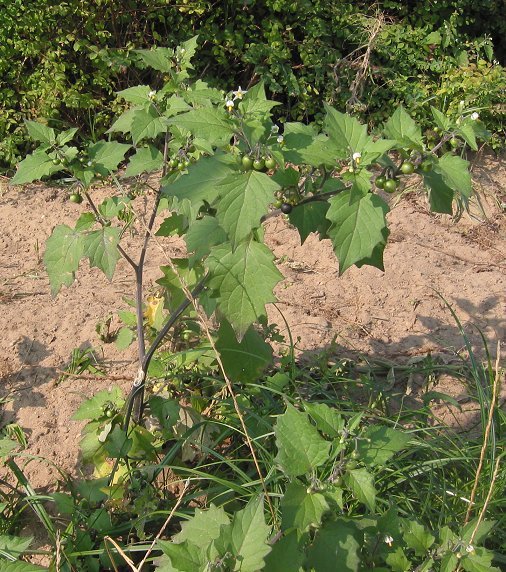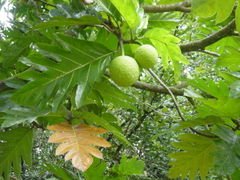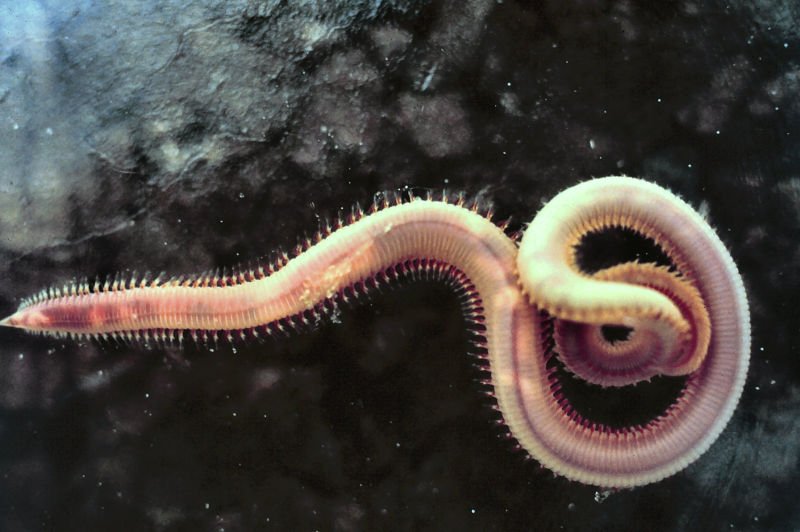... Long ago in the very beginning of time there dwelt within a shell an infant god whose name was Ta'aroa. He was Ta'aroa the unique one, the ancestor of all gods, the creator of the universe whose natures were myriad, whose backbone was the ridgepole of the world, whose ribs were its supporters. The shell was called Rumia, Upset.
Becoming aware at last of his own existence and oppressed by a yearning loneliness Ta'aroa broke open his shell and, looking out, beheld the black limitless expanse of empty space. Hopefully, he shouted, but no voice answered him. He was alone in the vast cosmos. Within the broken Rumia he grew a new shell to shut out the primeval void.
Eons passed and Ta'aroa grew to be a lad conscious of his own vigor and potentialities. Impatience grew upon him until he could bear his isolation no longer. He broke forth from his shell with energy, resolved to create beings like himself who would banish his loneliness forever. Ta'aroa's first act was to construct a firm foundation for the earth, using the strong second shell for stratum rock. The shell Rumia became his dwelling place, the overarching dome of the sky. It was a confined sky enclosing the world just forming, and in its deep and abiding night the lad attained manhood. There were no Sun, Moon, or stars and only one other living creature, the Great Octopus.
The sun was held down close above the slowly evolving earth by the Great Octopus, Tumu-rai-fenua, Foundation of Heaven and Earth, who lived in the primeval waters on which the earth floated. One of his arms was to the north, one to the south, one to the east and another to the west. With these vast arms he held the sky, the shell Rumia, close down against the earth.
Meanwhile on the earth itself various generations of rocks were born, one after the other; then sand appeared. Roots were born and as they spread they held the sand together and the land became firm.
Ta'aroa sat in his heaven above the earth and conjured forth gods with his words. When he shook off his red and yellow feathers they drifted down and became trees ... (Makemson, The Morning Star Rises.)
The idea of lost feathers could be related to te kihikihi:
| April 9 (464) |
10 (100) |
11 |
 |
 |
 |
| Ca1-19 |
Ca1-20 |
Ca1-21 |
| te maitaki - te kihikihi |
hakaraoa - te henua |
tagata huki |
| Spica, Alcor (202.7) |
|
|
| Kihi Kihikihi, lichen; also: grey, greenish grey, ashen. Vanaga.
Kihikihi, lichen T, stone T. Churchill.
The Hawaiian day was divided in three general parts, like that of the early Greeks and Latins, - morning, noon, and afternoon - Kakahi-aka, breaking the shadows, scil. of night; Awakea, for Ao-akea, the plain full day; and Auina-la, the decline of the day. The lapse of the night, however, was noted by five stations, if I may say so, and four intervals of time, viz.: (1.) Kihi, at 6 P.M., or about sunset; (2.) Pili, between sunset and midnight; (3) Kau, indicating midnight; (4.) Pilipuka, between midnight and surise, or about 3 A.M.; (5.) Kihipuka, corresponding to sunrise, or about 6 A.M. ... (Fornander) |
Sunset was kihi on Hawaii, and my rule of thumb for doublewords leads us to kihikihi as being its opposite, viz. dawn.
Metoro sometimes said kihikihi where we had expected maro, e.g.:
 |
 |
 |
| Cb5-1 |
Cb5-2 (488) |
Cb5-3 |
| July 20 |
21 |
22 (204) |
| Heka 12 |
13 (66) |
Alhena 1 |
| Te ragi |
tagata - ragi |
kua hakagana - ki te maro |
 |
 |
 |
 |
| Cb5-4 |
Cb5-5 |
Cb5-6 |
Cb5-7 (493) |
| July 23 |
24 |
25 |
26 (208) |
| Alhena 2 |
3 |
4 |
5 |
| tagata mau matagi |
ihe toga maa |
ura hia |
tagata maú kihikihi erua |
| Maro Maro: A sort of small banner or pennant of bird feathers tied to a stick. Maroa: 1. To stand up, to stand. 2. Fathom (measure). See kumi. Vanaga.
Maro: 1. June. 2. Dish-cloth T P Mgv.: maro, a small girdle or breech clout. Ta.: maro, girdle. Maroa: 1. A fathom; maroa hahaga, to measure. Mq.: maó, a fathom. 2. Upright, stand up, get up, stop, halt. Mq.: maó, to get up, to stand up. Churchill.
Pau.: Maro, hard, rough, stubborn. Mgv.: maro, hard, obdurate, tough. Ta.: mârô, obstinate, headstrong. Sa.: mālō, strong. Ma.: maro, hard, stubborn. Churchill.
Ta.: Maro, dry, desiccated. Mq.: mao, thirst, desiccated. Fu.: malo, dry. Ha.: malo, maloo, id. Churchill.
Mgv.: Maroro, the flying fish. (Ta.: marara, id.) Mq.: maoo, id. Sa.: malolo, id. Ma.: maroro, id. Churchill. |
"MALO ¹, s.
Haw., a strip of kapa or cloth tied
around the loins of men to hide the
sexual organs. Polynesian, ubique,
malo, maro, id., ceinture,
girdle-cloth, breech-cloth.
Sanskr., mal,
mall, to hold; malla, a cup;
maltaka, a leaf to wrap up
something, a cup; malâ-mallaka, a
piece of cloth worn over the privities.
Greek, μηρνομαι;
Dor., μαρνομαι, to draw up, furl,
wind round. No etymon in Liddell and
Scott.
MALO ², v.
Haw., to dry up, as water in pools or
rivers, be dry, as land, in opposition
to water, to wither, as vegetables
drying up; maloo, id., dry
barren.
Ta., maro, dry,
not wet; marohi, dry, withered. A
later application of this word in a
derivative sense is probably the Sam.
malo, to be hard, be strong;
malosi, strong; the Marqu. mao,
firm, solid; N. Zeal., maroke,
dry; Rarot., Mang., maro, dry and
hard, as land.
Sanskr., mŗi,
to die; maru,
a desert, a mountain; marut,
the deities of wind; marka,
a body; markara,
a barren woman; mart-ya,
a mortar, the earth; mîra,
ocean.
For the argument by which A. Pictet
connects maru
and mira
with mŗi,
see 'Orig. Ind.Eur', i. 110-111. It is
doubtless correct. But in that case 'to
die' could hardly have been the primary
sense or conception of
mŗi.
To the early Aryans the desert, the
maru,
which approached their abodes on the
west, must have presented itself
primarily under the aspect of 'dry,
arid, sterile, barren', a sense still
retained in the Polynesian
maro.
Hence the sense of 'to wither, to die',
is a secondary one. Again, those ancient
Aryans called the deity of the wind the
Marut;
and if that word, as it probably does,
refers itself to the root or stem
mŗi,
the primary sense of that word was
certainly not 'to die', for the winds
are not necessarily 'killing', but they
are 'drying', and that is probably the
original sense of their name.
Lat., morior,
mors,
&c.
Sax., mor,
Eng., moor,
equivalent to the Sanskr.
maru."
(Fornander)
|
Fornander perceives dry land as the origin of the
concept which the Polensian expressed as maro (malo). The
clearly drawn toes in front in Cb5-3 means there is dry land ahead,
therefore maro should be a better word than kihikihi.
There are no toes at tagata maú kihikihi erua ('a man holding
a pair of kihikihi').
Dryness could be illustrated in front in April 10 and Ca1-20 could be a picture of 'the year in straw' (winter), because there are 7 lifeless twigs and on Easter Island winter was ahead:
| April 9 (464) |
10 (100) |
11 |
 |
 |
 |
| Ca1-19 |
Ca1-20 |
Ca1-21 |
| te maitaki - te kihikihi |
hakaraoa - te henua |
tagata huki |
| Spica, Alcor (202.7) |
|
|
Ca1-19 could therefore illustrate the opposite, viz. the moist - which I guess kihikihi means - and fertile offspring (hua) part of the year. The uplifted sign is hua poporo, which possibly is illustrating breadfruit:
 |
 |
| Ca1-19 |
hua poporo |
Barthel informs us that the Maori singers in New Zealand, where the breadfruit did not grow, 'translated' kuru (= breadfruit) in their old songs - from the times when their forefathers lived in a warmer climate - into poporo.
He points
out that in the Marquesas they counted the fruits from the
breadfruit trees in fours, perhaps thereby explaining the four
'berries' in this type of glyph. The breadfruit did not grow on
Easter Island but the berries of Solanum nigrum were eaten in
times of famine.
Barthel
compares with the word koporo on Mangareva. The poor crop of
breadfruits at the end of the harvest season was called
mei-koporo, where mei stood for breadfruit. On other
islands breadfruit was called kuru, except in the Marquesas
which also used the word mei. Koporo was a species of
nightshade.

"Solanum
nigrum (Black Nightshade, Duscle, Garden Nightshade, Hound's
Berry, Petty Morel, Small-fruited black nightshade, Sunberry, or
Wonderberry) is a species in the Solanum genus, native to
Eurasia and also introduced in the Americas. In Hawaii it is
called popolo.
The
green berries and mature leaves contain glycoalkaloids and are
poisonous to eat raw. Their toxicity varies and there are some
strains which have edible berries when fully ripe. The plant has
a long history of medicinal usage, dating back to ancient
Greece. In India, the berries are casually grown and eaten; but
not cultivated for commercial use. In Tamil, the berries are
called sundakai
Black
nightshade is a fairly common plant, found in many wooded areas,
as well as disturbed habitats. It has a height of 30-120 cm
(12-48"), leaves 4-7.5 cm (1 1/2-3") long; ovate to
heart-shaped, with wavy or large-toothed edges. The flowers have
petals greenish to whitish, recurved when aged and surround
prominent bright yellow anthers. The fruits are oval black
berries in small hanging clusters." (Wikipedia)
"Breadfruit (Artocarpus altilis) is a tree and fruit
native to the Malay Peninsula and western Pacific islands. It
has also been widely planted in tropical regions elsewhere. It
was collected and distributed by Lieutenant William Bligh as one
of the botanical samples collected by HMS Bounty in the
late 18th century, on a quest for cheap, high-energy food
sources for British slaves in the West Indies ...
According to an etiological Hawaiian myth, the breadfruit
originated from the sacrifice of the war god Kū. After
deciding to live secretly among mortals as a farmer, Ku
married and had children. He and his family lived happily until
a famine seized their island. When he could no longer bear to
watch his children suffer, Ku told his wife that he could
deliver them from starvation, but to do so he would have to
leave them. Reluctantly, she agreed, and at her word, Ku
descended into the ground right where he had stood until only
the top of his head was visible. His family waited around the
spot he had last been day and night, watering it with their
tears until suddenly a small green shoot appeared where Ku
had stood. Quickly, the shoot grew into a tall and leafy tree
that was laden with heavy breadfruits that Ku's family
and neighbors gratefully ate, joyfully saved from starvation
..." (Wikipedia)

"... In Tahiti the
bread-fruit can be gathered for seven months, for the other
five there is none: for about two months before and after
the southern solstice it is very scarce, but from March to
August exceedingly plentiful. This season is called
pa-uru (uru = 'bread-fruit'). The recurring
scarcity of bread-fruit shewed the changes in the course of
the year, but the Pleiades afforded a surer limit.
In Samoa one authority
gives the wet season, ending in April, and the dry season,
which comes to an end with the palolo fishing in
October; another vaipalolo the palolo or wet
season from October to March, and toe lau,
when the regular trade-winds blow, embracing the other
months; a third the season of fine weather - in which
however much rain falls in some localities - and the stormy
season, when it rains heavily ..." (Martin P.
Nilsson, Primitive Time-Reckoning.)

"The palolo worm or Samoan palolo worm (Palola
viridis) is a species of invertebrate in the
Eunicidae family ..." (Wikipedia)
|












